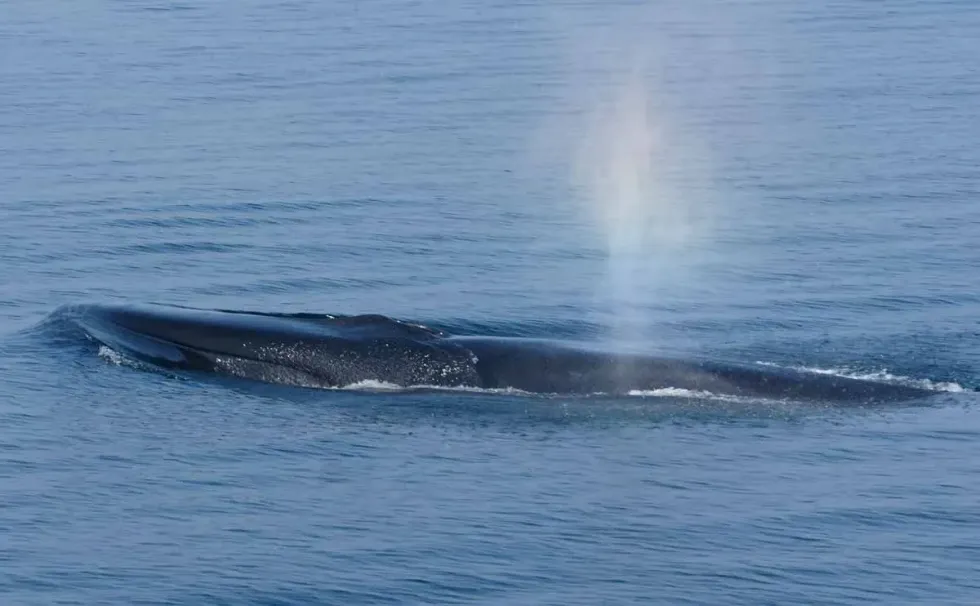The fin whale, also known as the finback whale, the common rorqual whale, or razorback whale, is known to be the second-largest mammal in the world after the blue whale. They are a type of baleen whale, which means they have baleen plates inside their mouth instead of teeth.
Fin whales are around 21-79 ft (6.4-24 m) in length and they weigh about 105,822-176,370 lb (48-80 metric tons).
They have long, slender bodies that are very graceful and regal. They are called the greyhounds of the ocean for their looks.
The main feature of the fin whale is its asymmetrical coloring. They are normally dark grey on top, while the underside is a paler gray.
But their right and left lower jaws are drastically different. The right lower jaw is usually paler with a lot of markings, while the left is dark gray. This is said to give them a hunting advantage.
There are around 100,000 fin whales living in the world today as most of them were hunted during the 20th century. Read on if you want to know more interesting fin whale facts.
If you want more articles rife with information like this one, check out fluke fish facts and skate fish facts.
Fin Whale Interesting Facts
What type of animal is a Fin Whale?
The fin whale (Balaenoptera physalus) is a type of baleen whale.
What class of animal does a Fin Whale belong to?
The fin whale (Balaenoptera physalus) belongs to the Mammalia class of the Animalia kingdom.
How many Fin Whales are there in the world?
The estimated population of fin whales around the world is about 100,000. Though different studies predict the numbers differently, it is an estimated average that there are 100,000 fin whales left in the world.
They lessened in numbers drastically due to commercial whaling in the 20th century. Some of their main threats now are global warming, ship strike, and habitat loss.
Where does a Fin Whale live?
The fin whales are found in all the major oceans and seas in the world. Other than places closer to the northern and southern ice-covered oceans, they are found in every other ocean.
They prefer temperate to cool waters and are less likely to be seen in tropical waters. In the summer months, they are seen in the North Pacific Ocean, Gulf of Alaska, and Gulf of California. And in the winter, they are found around Japan, and China.
What is a Fin Whale's habitat?
Fin whales prefer temperate to cool water bodies. They do not like the extreme cold of the polar regions. They are also rarely found in the equatorial regions where the temperature is too high. They are found in both the northern hemisphere and the southern hemisphere of the world.
They are migratory animals as they move around seasonally through the oceans to find food. They move to warmer waters during winter and to cooler, temperate regions during summer. Their migratory structure is not very well understood.
Who do Fin Whales live with?
Fin whales are social animals and can be found in groups of up to 10. They are also seen to be feeding in larger groups that can contain more than one species of whales, and dolphins.
How long does a Fin Whale live?
Fin whale's life span can be upto 94 years. However, fully mature fin whales are 25 years of age.
How do they reproduce?
Fin whales are believed to be monogamous and reach their reproductive maturity at the age of 6-10 years. They can often be seen in pairs in the ocean during the mating season.
One calf is born every two to three years. The gestation period is about 11-12 months.
As fin whales are one of the largest marine mammals in existence, second in size only to the enormous blue whale, their calves also give testimony to their size. A newborn fin whale calf is 20 ft (6 m) long and weighs around 7,000 lb (3,175.1 kg).
What is their conservation status?
Fin whales are not extinct but are listed as Vulnerable in the IUCN Red List (International Union for Conservation of Nature) of threatened species. Commercial whaling is one of the main reasons behind their dramatic fall in numbers. They are hunted in numbers by Greenlanders in the North Atlantic.
Over 725,000 fin whales were hunted in the 20th century alone. This led to the near-extinction of their species.
The International Whaling Commission (IWC) has rules on hunting fin whales. Fin whales are still hunted under the IWC's (International Whaling Commission) Aboriginal Substances Whaling provision. There are about 100,000 fin whales living in the world today.
Fin Whale Fun Facts
What do Fin Whales look like?

Fin whales are a breed of large whales. They are almost 21-79 ft (6.4-24 m) in length and weigh around 105,822-176,370 lb (48-80 metric tons).
They generally have a long and slender body that has earned them the name of 'greyhound of the sea'. Their skin is dark grey-black on top, and the underside of their bodies is light gray and pale. They have a long back, tall spout, and distinguishable dorsal fin.
They have asymmetrical coloration. The right side of their head sports complex markings, while the left side is often dark gray. Their right lower jaw and left lower jaw also look vastly different in color.
They also sport some lines around their bodies. These markings are more often seen in the fin whales of the North Atlantic than of the North Pacific.
The Fin whales earned the name 'razorback' for their dorsal fin, which has a distinct ridge running behind it. Like other Baleen whales, Fin whales have baleen plates inside the mouth instead of teeth. These plates spray into fine hairs on both sides of their mouths.
The adult Fin whales have 250-400 baleen plates. These plates help them ingest large amounts of food at once. The asymmetrical pigmentation in their two jaws is found in Omura's whales, but the reason behind this is uncertain.
How cute are they?
Because of their size and looks, fin whales can hardly make the list of cute animals. You wouldn't think of petting one of these if you ever come across it. Your first thought would be to get out of there as quickly as possible. But fin whale babies do look really cute.
How do they communicate?
Fin whales, much like blue whales, communicate with each other through vocalization. They produce low-frequency sounds that pierce through the water and can reach far. Their vocalizations are called whale songs. Even though the sounds are usually lower than the average human's hearing capacities, higher sounds have been recorded to communicate to other whales.
Their vocalizations range from 16-40 Hz. They also produce 20 Hz pulses. Their sounds are used to determine threats and prey in the ocean. But they also communicate to other whales about their whereabouts through them. The fin whales produce one of the loudest noises in the ocean.
How big is a Fin Whale?
Fin whales are the second-largest whales after blue whales. They are very large and yet slender-bodied. They are around 21-79 ft (6.4-24 m) long and weigh around 105,822-176,370 lb (48-80 metric tons). Being the second-largest animal in the world, an average fin whale is more than 10-12 times the size of a tall human.
How fast can a Fin Whale move?
They can swim at a speed of 25 mph (40.2 kph) on average, making them the fastest great whales. Their slender bodies and dorsal fin help them reach this speed in the water. In short bursts, they have been known to reach the speed of 30 mph (48.2 kph).
How much does a Fin Whale weigh?
Fin whales are a breed of very large whales. An average fin whale weighs around 105,822-176,370 lb (48-80 metric tons). The female fin whales are larger than the male fin whales and consequently weigh more.
What are their male and female names of the species?
Like other whales, male fin whales are called bulls while the females are called cows.
What would you call a baby Fin Whale?
A baby fin whale is called a calf.
What do they eat?
Fin whales are filter feeders. They feed on schools of fish, squids, and krills. Their large mouths are capable of taking in huge amounts of food and water at once.
Their daily intake of food is almost 4000 lb (1800 kg). They can eat up to 22 lb (10 kg) in one gulp. They might hunt in pods of up to eight whales, but much larger pods have also been seen around the world, though rarely.
Are they dangerous?
Despite their overwhelming size as one of the largest marine mammals, fin whales are not predatory animals. Like other baleen whales, they feed on small schooling fish, skrill, and squids. They are completely harmless to people. The only times that a fin whale has been lethal to people is in cases of accidental collisions and whaling incidents.
Would they make a good pet?
Absolutely not. Fin whales are too big to be kept in captivity and are only found in oceans and seas. It is physically impossible to keep a fin whale alive in captivity. They can be seasonally observed in places they frequent, but they cannot be kept as pets.
Did you know...
Fin whales are the second-largest living mammals in the world, second only to the Blue whale.
The only known natural predator of the fin whale is killer whales. They might hunt the vulnerable old fin whales or calves. Since the adult fin whales are so massive and fast, they can get away if there is a killer whale attack.
Fin whales were formally known as herring whales.
They have asymmetrical coloring. The lower jaw's right side is lighter with patterns, while the left is usually dark grey. This is believed to help them in hunting.
Fin whales make the lowest frequency sound in the ocean.
Fin whales can dive as far as 1800 ft (550 m) in the sea and can stay underwater for about 20 minutes.
Is the Fin Whale endangered?
Fin whales are listed as Vulnerable in the IUCN Red List of Threatened species. They were severely hunted during the 20th century for commercial whaling.
This made the population of fin whales a fraction of what it was before commercial whaling. Fin whales are a vulnerable species. In recent times, they are also exposed to ship-related accidents that are decreasing the numbers of fin whales further.
Global warming is also dangerously affecting their health and numbers. Water pollution and several other man-made reasons are behind the lessening numbers of whales.
Why is the Fin Whale important?
Like every other whale, fin whales are a very important part of the marine ecosystem. They are at the very top of their food chain. They have an important role to play in the health of the marine environment.
Yet, they drastically lessened in numbers because of commercial whaling in the 20th century. Now, the main threats that they face are global warming, water pollution, habitat loss, ship strikes. Most of these issues are man-made as there are very few other things that can threaten this massive creature.
Here at Kidadl, we have carefully created lots of interesting family-friendly animal facts for everyone to discover! Learn more about some other mammals, including dugongs and Amazon river dolphins.
You can even occupy yourself at home by drawing one on our fin whale coloring pages.










